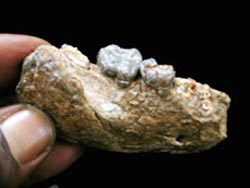Anthropologists find 4.5 million-year-old hominid fossils in Ethiopia

Photo by: Sileshi Semaw <br>IU Bloomington paleoanthropologist Sileshi Semaw holds the fossil of a hominid mandible (lower jaw bone) believed to be about 4.5 million years old
Scientists from Indiana University Bloomington and seven other institutions have unearthed skeletal fossils of a human ancestor believed to have lived about 4.5 million years ago. The fossils, described in this week’s Nature (Jan. 20), will help scientists piece together the mysterious transformation of primitive chimp-like hominids into more human forms.
The fossils were retrieved from the Gona Study Area in northern Ethiopia, only one of two sites to yield fossil remains of Ardipithecus ramidus. “A few windows are now opening in Africa to glance into the fossil evidence on the earliest hominids,” said IUB paleoanthropologist Sileshi Semaw, who led the research.
Semaw and colleagues also report new evidence that suggests the human ancestors lived in close quarters with a menagerie of antelope, rhinos, monkeys, giraffes and hippos in a northern Ethiopia that was far wetter than it is today. The environmental reconstructions suggest a mosaic of habitats, from woodlands to grasslands. Research is continuing at Gona to determine which habitats A. ramidus preferred.
“We now have more than 30 fossils from at least nine individuals dated between 4.3 and 4.5 million years old,” said Semaw, Gona Palaeoanthropological Research Project director and Stone Age Institute research scientist. The Stone Age Institute, a new research center dedicated to the study of early human evolution and culture, is affiliated with Indiana University’s CRAFT, the Center for Research into the Anthropological Foundations of Technology.
In their letter to Nature, Semaw and his coauthors describe parts of one upper and two lower jaw bones — with teeth still intact — several loose teeth, part of a toe bone and intact finger bones. The scientists believe the fossils belong to nine individuals of the species A. ramidus. The scientists used argon isotope dating of volcanic materials found in the vicinity of the fossils to estimate their age.
In the 11 years since the naming of A. ramidus by University of California Berkeley anthropologist Tim White and colleagues, only a handful of fossils from the species have been found, and only at two sites — the Middle Awash and Gona, both in Ethiopia. Other fossils of slightly older age are known in Kenya and Chad. Anthropologists working in Ethiopia believe Ardipithecus is the first hominid genus — that is, human ancestors who lived just after a split with the lineage that produced modern chimpanzees.
Despite the millions of years that separate us, modern humans have a few things in common with A. ramidus. Fossils from Gona and elsewhere suggest that the ancient hominid walked on two feet and had diamond-shaped upper canines, not the “v”-shaped ones chimps use to chomp. Outwardly, however, A. ramidus would appear a lot more chimpanzee-like than human.
Gona has turned out to be a productive dig site. In a Nature cover story (Jan. 23, 1997), Semaw and colleagues reported the oldest known stone tools used by ancestral humans. The Gona artifacts showed that as early as 2.5 million years ago, hominids were remarkably skilled toolmakers. Last month (December 2004), Semaw coauthored a paper in Geological Society of America Bulletin summarizing Gona’s geological properties and the site’s cornucopia of hominid fossils spanning several million years. (Science magazine gave the article an “Editor’s Choice” nod.)
Media Contact
More Information:
http://www.indiana.eduAll latest news from the category: Earth Sciences
Earth Sciences (also referred to as Geosciences), which deals with basic issues surrounding our planet, plays a vital role in the area of energy and raw materials supply.
Earth Sciences comprises subjects such as geology, geography, geological informatics, paleontology, mineralogy, petrography, crystallography, geophysics, geodesy, glaciology, cartography, photogrammetry, meteorology and seismology, early-warning systems, earthquake research and polar research.
Newest articles

Bringing bio-inspired robots to life
Nebraska researcher Eric Markvicka gets NSF CAREER Award to pursue manufacture of novel materials for soft robotics and stretchable electronics. Engineers are increasingly eager to develop robots that mimic the…

Bella moths use poison to attract mates
Scientists are closer to finding out how. Pyrrolizidine alkaloids are as bitter and toxic as they are hard to pronounce. They’re produced by several different types of plants and are…

AI tool creates ‘synthetic’ images of cells
…for enhanced microscopy analysis. Observing individual cells through microscopes can reveal a range of important cell biological phenomena that frequently play a role in human diseases, but the process of…





















